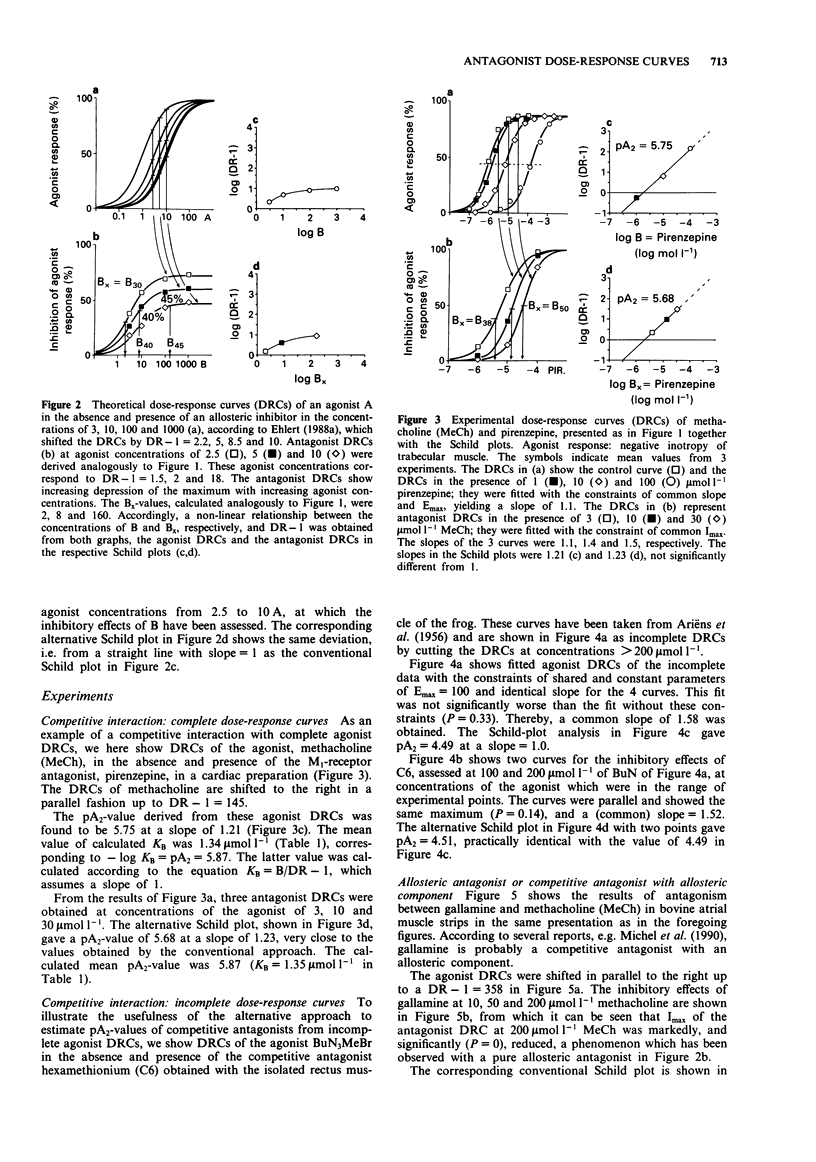Abstract
1. One aim of this paper is to show an alternative approach for the determination of antagonist affinity estimates, KB and pA2, by construction and evaluation of antagonist dose-response curves (DRCs), using the curve-fitting programme, ALLFIT. 2. Parallel antagonist DRCs were derived by vertical analysis of families of conventional agonist DRCs in the presence and absence of an antagonist at a certain agonist concentration above its ED50. The latter represents a chosen, i.e. fixed dose-ratio (DR). The antagonist concentration that reduces an agonist effect to its Emax/2 was termed Bx. It corresponds to B, the fixed antagonist concentration, tested to obtain DR-1, conventionally. 3. The dissociation constant was calculated as KB = Bx/DR-1, analogous to the conventional approach (KB = B/DR-1). Likewise, pA2-values were estimated by plotting log Bx, obtained by the alternative approach, vs log (DR-1) in an 'alternative Schild plot'. 4. Experimental agonist DRCs from our laboratory and from the literature were analysed and KB- and pA2-values obtained by the alternative approach were compared with those obtained by the conventional method. The results showed a very good agreement (correlation) between the pA2-values obtained by either method (slope = 1.02, r = 0.99, n = 9), in agreement with theoretical DRCs. 5. Besides estimation of KB and pA2, antagonist DRCs were also evaluated qualitatively. The most important finding was that allosteric antagonists or competitive antagonists with an allosteric component, such as gallamine, showed a significant reduction in the maximum of the antagonist DRCs (Imax). The evaluation of antagonist DRCs appears to be a sensitive procedure to detect allosteric interactions.(ABSTRACT TRUNCATED AT 250 WORDS)
Full text
PDF






Selected References
These references are in PubMed. This may not be the complete list of references from this article.
- ARIENS E. J., VAN ROSSUM J. M., SIMONIS A. M. A theoretical basis of molecular pharmacology. I. Interactions of one or two compounds with one receptor system. Arzneimittelforschung. 1956 May;6(5):282–293. [PubMed] [Google Scholar]
- ARUNLAKSHANA O., SCHILD H. O. Some quantitative uses of drug antagonists. Br J Pharmacol Chemother. 1959 Mar;14(1):48–58. doi: 10.1111/j.1476-5381.1959.tb00928.x. [DOI] [PMC free article] [PubMed] [Google Scholar]
- Cheng Y., Prusoff W. H. Relationship between the inhibition constant (K1) and the concentration of inhibitor which causes 50 per cent inhibition (I50) of an enzymatic reaction. Biochem Pharmacol. 1973 Dec 1;22(23):3099–3108. doi: 10.1016/0006-2952(73)90196-2. [DOI] [PubMed] [Google Scholar]
- Eglen R. M., Whiting R. L. Problems associated with the application of the Cheng-Prusoff relationship to estimate atropine affinity constants using functional tissue responses. Life Sci. 1989;44(1):81–94. doi: 10.1016/0024-3205(89)90221-x. [DOI] [PubMed] [Google Scholar]
- Ehlert F. J. Estimation of the affinities of allosteric ligands using radioligand binding and pharmacological null methods. Mol Pharmacol. 1988 Feb;33(2):187–194. [PubMed] [Google Scholar]
- Ehlert F. J. Gallamine allosterically antagonizes muscarinic receptor-mediated inhibition of adenylate cyclase activity in the rat myocardium. J Pharmacol Exp Ther. 1988 Nov;247(2):596–602. [PubMed] [Google Scholar]
- Kenakin T. P. Theoretical and practical problems with the assessment of intrinsic efficacy of agonists: efficacy of reputed beta-1 selective adrenoceptor agonists for beta-2 adrenoceptors. J Pharmacol Exp Ther. 1982 Nov;223(2):416–423. [PubMed] [Google Scholar]
- Lee N. H., el-Fakahany E. E. Influence of ligand choice on the apparent binding profile of gallamine to cardiac muscarinic receptors. Identification of three main types of gallamine-muscarinic receptor interactions. J Pharmacol Exp Ther. 1988 Sep;246(3):829–838. [PubMed] [Google Scholar]
- Michel A. D., Delmendo R. E., Lopez M., Whiting R. L. On the interaction of gallamine with muscarinic receptor subtypes. Eur J Pharmacol. 1990 Jul 3;182(2):335–345. doi: 10.1016/0014-2999(90)90292-e. [DOI] [PubMed] [Google Scholar]
- Persson C. G., Karlsson J. A., Erjefält I. Differentiation between bronchodilation and universal adenosine antagonism among xanthine derivatives. Life Sci. 1982 Jun 21;30(25):2181–2189. doi: 10.1016/0024-3205(82)90292-2. [DOI] [PubMed] [Google Scholar]
- Pöch G., Zimmermann I. Simple pA2 estimation of partial agonists: comparison with the Kaumann-Blinks method. J Pharmacol Methods. 1988 Mar;19(1):47–56. doi: 10.1016/0160-5402(88)90044-7. [DOI] [PubMed] [Google Scholar]
- Rodbard D. Statistical quality control and routine data processing for radioimmunoassays and immunoradiometric assays. Clin Chem. 1974 Oct;20(10):1255–1270. [PubMed] [Google Scholar]
- Roffel A. F., Elzinga C. R., Meurs H., Zaagsma J. Allosteric interactions of three muscarine antagonists at bovine tracheal smooth muscle and cardiac M2 receptors. Eur J Pharmacol. 1989 Mar 7;172(1):61–70. doi: 10.1016/0922-4106(89)90045-x. [DOI] [PubMed] [Google Scholar]
- SCHILD H. O. Drug antagonism and pAx. Pharmacol Rev. 1957 Jun;9(2):242–246. [PubMed] [Google Scholar]
- Tallarida R. J., Cowan A., Adler M. W. pA2 and receptor differentiation: a statistical analysis of competitive antagonism. Life Sci. 1979 Aug 20;25(8):637–654. doi: 10.1016/0024-3205(79)90505-8. [DOI] [PubMed] [Google Scholar]


